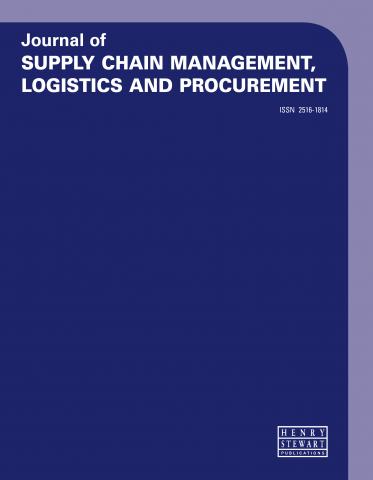“The thought leadership and knowledge sharing by industry experts contained within this Journal truly exemplifies how cyber security is a non-competitive environment.”
Instructions for authors
Style
1. The Journal particularly welcomes contributions from supply chain management, logistics and procurement professionals including best practice articles; case studies; new approaches and techniques; applied research; legal and regulatory updates; or other material of relevance to senior professionals. They can be more descriptive (and less analytical) of current business practice and need not display in-depth knowledge of previous academic work in the field. The Journal also publishes traditionally styled academic papers which are expected, at a minimum, to display a sound knowledge of previous work in the area and some original research content. All articles must have clear implications for business practice.
2. Articles and papers can be anywhere from 3,000 to 6,000 words. Longer pieces will be considered for peer-review, at the discretion of the Publisher.
3. Authors should not seek to use the Journal as a vehicle for marketing any specific product or service.
4. Articles and papers must be supported by references to examples, statistics and case studies, and wherever possible industry surveys and existing literature.
5. References should be in the Vancouver system i.e. referred to by number in the text with superscripted numbers (like so¹) and set out in full in a consecutive numerical list at the end of the article. When referring to the same book or journal more than once, authors should not revert to the original number. Rather, a different (consecutive) number is inserted. Then, at the end of the article, the correct style is 'Surname (of author), ref x. above', or if it refers to the reference immediately preceding, 'Ibid' is inserted in the list.
6. Submissions should be written in the third person and authors should avoid the use of personal pronouns, slang and any other language which is not in keeping with the professional and academic style of the Journal.
7. Tables and graphs should be submitted in Word or Excel format. PowerPoint slides and screengrabs should be avoided, but where no other option is available (e.g. showing an on-screen operating system) they can be used.
8. All papers should be accompanied by a short abstract of up to 300 words summarising the paper. Please note the abstract should not provide a general introduction to the paper but rather should describe the aims and scope of the article and what the reader will take away from it including its purpose or problems addressed; what was done; any findings or trends identified; and the conclusions and any wider implications.
9. All articles should be accompanied by 4-6 keywords which summarise the key themes of the article.
10. Article should be accompanied by a short (up to 200 words) description of the author(s) and, if appropriate, the organisation of which he or she is a member.
11. All acronyms such as titles of organisations etc should be written out first in full and thereafter in their initials.
12. Photographs and illustrations supporting articles should be submitted where appropriate. Photographs should be submitted electronically with figures saved as TIF, EPS/PDF with all fonts embedded or JPEG (high resolution) files at a minimum 300dpi and preferably in black and white. Further guidance on the submission of graphics is available on request from the Publisher, Simon Beckett, at simon@hspublications.co.uk
13. With appropriate exceptions, eg pints and gallons, measurements should be in metric units.
14. Please note that the journal’s format does not permit sidebars. Any content contained in a sidebar should be worked into the text.
General
15. Papers should be submitted via email in Microsoft Word format to the Publisher, Simon Beckett, at simon@hspublications.co.uk
16. We do not charge authors for submission or publication of their paper.
17. Authors must ensure that references to named people and/or organisations are accurate, not racist or sexist and without libellous implications.
18. All contributions sent to the Publisher, whether invited or not, will be submitted to the Journal's Editors and Editorial Board for anonymous peer-review. Any such contribution must bear the author's full name and address, even if this is not for publication, although this is removed for the duration of the peer-review process. Contributions, whether published pseudonymously or not, are accepted on the strict understanding that the author is responsible for the accuracy of all opinion, technical comment, factual report, data, figures, illustrations and photographs. Publication does not necessarily imply that these are the opinions of the Editorial Board, Editors or the Publisher, nor do the Board, Editors or Publishers accept any liability for the accuracy of such comment, report and other technical and factual information. The Publisher will, however, strive to ensure that all opinion, comments, reports, data, figures, illustrations and photographs are accurate, insofar as it is within its abilities to do so. The Publisher reserves the right to edit, abridge or omit material submitted for publication.
19. Authors should be aware that papers submitted to the Journal should not be simultaneously submitted for review to any other publications.
20. The author bears the responsibility for checking whether material submitted is subject to copyright or ownership rights, eg photographs, illustrations, trade literature and data. Where use is so restricted, the Publisher must be informed with the submission of the material.
21. No contribution will be accepted which has been published elsewhere, unless it is expressly invited or agreed by the Publisher. Papers and contributions published become the copyright of the Publisher, unless otherwise agreed.
22. All reasonable efforts are made to ensure accurate reproduction of text, photographs and illustrations. The Publisher does not accept responsibility for mistakes, be they editorial or typographical, nor for consequences resulting from them.


